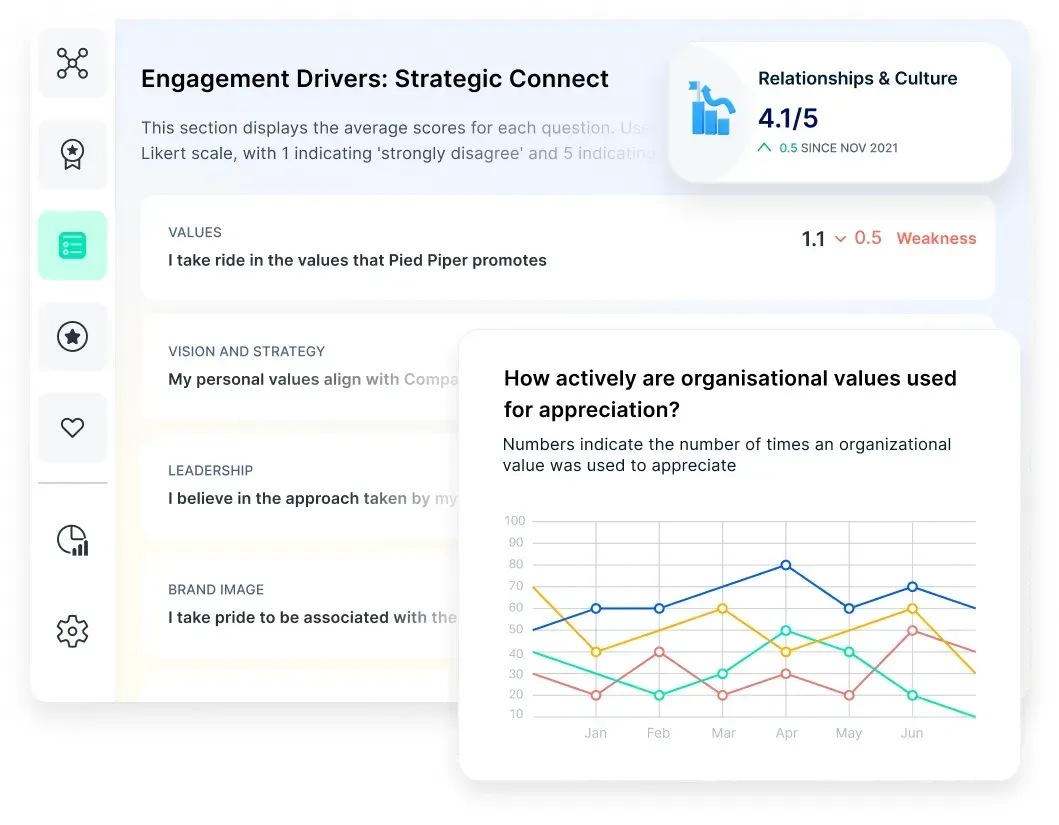Top 10 Employee Relation Strategies to Build a Thriving Workplace
Explore proven employee relation strategies that enhance workplace harmony, reduce turnover, and foster meaningful connections across teams and leadership.
On this page
- Why building relationships at work is important?
- How to build strong, effective & positive relationships at work?
- What is employee relationship management?
- Why is employee relationship management important?
- 10 Strategies and best practices for improving employee relations in the workplace
- Employee relationship management with Empuls
- Focusing on coworker relations: The way forward
- FAQs
An organization comprises individuals with diverse backgrounds coming together, driven by one ambition excelling in their tasks and contributing to the success of their organization. For either or both to see the light of the day, we must acknowledge the interdependencies in the ecosystem.
None of us can survive, work, or achieve any milestone in isolation as we are humans – the social beings dependent on relationships in all spheres of our lives, work is one of them. Words fall short to stress the importance of building relationships in the workplace and nurturing co-workers.
The work relationships are not always by choice hence most of us may only associate with a colleague for a project or an assignment. We may naturally not feel the need to strengthen this relationship but what will happen if we do work towards sustaining it?
For any relationship to work, it takes two. So also, at work! At the very first go, naturally, we tend to associate ourselves close to those with whom we find some traits or habits in common.
What is important though is to look beyond this natural selection and put an effort in building and sustaining those relationships that are beneficial to you and add to you as a professional. For example – interdepartmental relationships or mentor-mentee relationships.
Remember any relationship must be a value add for both the involved parties, in absence of which the relationship over time will become obsolete. Identify those relationships, it could take time but will be worth your effort. Make this a part of your work habit to invest time in building work relationships as you progress in your journey within an organization.
Why building relationships at work is important?
Firstly, for our basic existence – our tendency to have someone with whom we can share our life and its journey. The same is true in the organizational context too, in maintaining co-worker relationships. Having a culture of positive work relationships enables:
1. The working atmosphere to be fun and lively
Remember that first day at school, college, or in your new organization. How would it be to spend a considerable amount of time every day feeling the same? Not so much fun, isn’t it? While it is important to give undivided attention to the work and be diligent, it does not stop you from having those light moments at work.
Take time to crack a joke, share fun photos, and cherish it. Empuls allows for employees to form such fun and hobby groups bringing together people of similar interests -stressing the importance of building relationships in the workplace.
2. Creates a sense of belonging
It surely feels good to come to a place where we have friends or acquaintances. No doubt that 82% of the employers rated employee referral as the best resource for generating ROI. Apart from this, having friends at work helps enhance retention, manage work stress, and creative problem solving to name a few.
3. Sharing of knowledge within employees and teams
Knowledge once gained is a treasure forever. But it only increases if shared! Teams can collaborate on projects or a problem statement and brainstorm. The free flow of information within the organization promotes the culture of learning and allows for employee self-development.
4. High performing teams
Good relationships in the workplace allow for the best of each employee to come out. We are open to feedback and learning from each other. We take pride in each other’s success and stand together in failure.
This enhances the cohesion in the team and keeps the team focused on the end goal as against focusing on counterproductive aspects of an unhealthy relationship.
5. Feedback sharing and receiving
An effective feedback exercise has a positive relationship in its foundation. It also makes the feedback more credible if it comes from someone with whom you have a healthy work relationship. We receive it with an open mind, tend to take it positively, and work for betterment.
6. Celebrating each other’s success
Peer-to-peer recognition is one of the motivators that drive excellence in our deliveries. Having your colleague or a friend at work talk about your journey to success, write an appreciation note for you on the company intranet builds a culture of open recognition and promotes the idea of team spirit.
7. Helps in your career growth
Meeting, interacting, and learning from people of diverse backgrounds contributes to enhancing knowledge and sharpening interpersonal skills. It makes us sensitive towards personal preferences, cultural nuances and gives insight into different roles that people play within the organization.
As we go higher up the career ladder, our roles become more functional involving interactions with people in the form of employees, clients, customers, stakeholders, etc. Having good knowledge of people, their sensitivities, and having good work relationships will enable effective people management and interactions.
How to build strong, effective & positive relationships at work?
Now that we have learned why building relationships at work is important, let’s explore how to build strong, effective & positive work relationships.
1. It starts with you
Share about yourself. Reach out first. Not everyone is effective in making strong relationships but seeing your consistent approach, the other party will reciprocate. It also brings forth your approachable self and encourages others to start feely interacting with you.
2. Support others in their endeavors
Relationships are a two-way street. While you seek help from others, support others in their assignments. Offer help and guidance. Be an honest critic but in a constructive manner.
3. Ask for help
Be open in acknowledging your shortcomings or need for help. This presents you as an honest person. It further encourages others to accept their improvement areas candidly in front of you. It shows you are open to learning and are a knowledge-seeking person.
4. Thank them
Appreciation at any level of the hierarchy is always welcome. It is a small gesture that goes a long way in strengthening your relationship. Acknowledging the support and help received from others, promotes a culture of teamwork and collaboration.
5. Be in touch even if not in need
it is good to receive a call or a message which is only focused on checking on our wellbeing and the sender is not expecting anything in return. Acts like these set foundations for the long-term association as it shows that you are not only focused on getting your work done or asking for favors but are genuinely interested in having a healthy relationship.
6. Invest time
Building relationships takes time. Do not brush off people post your one-time interaction or project completion. Take time to know people. You may not need to spend hours in a day to work on it but see if you can continue with the regular greeting, thank the person for help, share credit, and wish them on important occasions.
7. Maintain a professional approach
Do not cross the line. Be respectful and respect the space of the other person. Remember your relationship is a working relationship and you may not want to come across as someone who is interfering in someone’s work and personal space.
8. Pay attention to others
Communication is an important ingredient in any good relationship in the workplace and listening is a key element in it. It is a skill and having good listening skills can enable strengthening your work related to a great extent.
Build great work relationships with Empuls tools
Following is a breakdown of how you can use Empuls to build relationship with employees.
Employees form a vital part of an organization and are responsible for its growth. There is a complementary relationship between the business and its employees. To maintain this, paying attention to employee relationship management is essential.
What is employee relationship management?
Managing the vertical and horizontal relationships in an organization is employee relationship management. While the vertical relationship is between the employees and the managers/top management, the horizontal relationship is between the employees.
Employees should be able to communicate freely without any hesitation to maintain a positive work atmosphere.
Why is employee relationship management important?
Some of the reasons you should pay attention to employee relationship management are listed below:
1. Improves productivity
Maintaining healthy relationships in an organization builds a better work environment. This may be between members of a team, manager and subordinate, between departments, etc.
When employees are happy at work, they contribute better. This helps the business grow well. Employees with strained relations lack the motivation to work, impacting productivity greatly.
2. Improves employee loyalty
Loyal employees are a blessing to an organization. Employees will be loyal only if the organization shows a genuine interest in their welfare. Employee relationship management is one of the factors that can contribute to loyalty.
When the organization nurtures employee relationships by adopting proper strategies, it will motivate them to stay loyal and continue for a long time.
3. Promotes harmony by reducing conflicts
Harmony among team members and also between different departments is highly imperative for the smooth running of a business. There should be proper understanding and coordination so that everyone works toward the common goal of the business.
Adopting employee relationship management strategies reduces friction and improves teamwork. This ultimately leads to improved productivity.
4. Reduces employee turnover
When employees do not have good relationships at the workplace, it leads to absenteeism and gradually, an increased turnover. Huge employee turnover costs a lot to an organization.
Through proper employee relationship management, an organization can improve the satisfaction level of employees. This helps in retaining them for a long time.
10 Strategies and best practices for improving employee relations in the workplace
Explore some of the best and tested ways to improve employee relations in the workplace. You can also download our free guide on how to practically manage a remote team (+bonus tips for remote team management).
1. Give constructive feedback
Employee evaluation is not just a measure to determine incentives. It should focus on how they can contribute more to their work to get robust results for the corporation, and that starts with getting authentic feedback for their performance.
Give employee feedback regularly to tell them how reliable they are at their work, not merely when the performance audits are on edge, but routinely to help them implement the feedback and improve on the go.
Here are a few approaches you can use to extend constructive feedback to your employees:
- Be precise and straightforward about the “what” and “why” of your feedback.
- Avoid emails or phone calls, and use videos or in-person discussions for giving feedback.
- Have a sincere and candid tone.
- Be fully aware of the situation before giving feedback.
- Once you give your feedback, allow the employee a chance to respond.
- Don’t shy away from pointing out mistakes, however, respectfully.
“The results of your analysis were impressive, but here’s how you can make minor changes to get better results.” Acknowledging their good performance and providing them ways to improve is an essential aspect of constructive feedback.
This will encourage them to recognize their mistakes and strengths, motivating them to achieve outstanding business and personal goals.
2. Increase communication with regular check-ins
Your employees play a make or break factor in your business success. They are the most significant resources you have. So, simply assigning them tasks and taking updates is probably not the best way to move forward.
Enhancing communication with your employees with routine checks will help bring up any issues they face at work or any problems they want to discuss. It’ll also help resolve one of the most significant employee relationship issues- conflict management by mediating disputes and finding midway solutions for them.
Here are few actions you can take to establish effective communication and improve employee experience:
- Encourage face-to-face conversations or video calls regularly if working remotely to strengthen work relations.
- Know when to switch from email to one-on-one conversations in real-time.
- Re-consider your Human Resources communications strategy. An employee communications app like Slack can come in handy to raise the bar for employee engagement.
- Be innovative with internal email communications. Apart from work communication, share engaging content like memes, videos, company blogs, or infographics to provide educational resources and promote light humor.
- You can even use surveys to understand how employees feel about the current communication structure and improve accordingly.
The idea is to look approachable to employees for any problems. Finding solutions together, showing support, and acknowledging their thoughts can go a long way.
3. Provide training and opportunities to upskill
Training and upskilling opportunities are crucial for employee growth and development. Providing resources, webinars, courses, etc., will help them get better at work and ultimately benefit the company.
Establishing such opportunities will help you:
- Increase employee satisfaction
- Boost employee morale
- Enhance productivity at work
- See a learning curve in performance and growth
- Reduce employee disengagement
There are various ways to present such opportunities. However, here are some ideas to begin with:
- Workshops or webinars
- People skills training
- Technical training
- Higher education reimbursements
- Guest speaking forums
- Free access to e-learning platforms
4. Create a culture that promotes transparency
Being open and loyal to your employees about the company’s accomplishments and anxieties, however demanding they may be, creates a culture of transparency.
Moreover, creating a work environment that empowers them to voice their concerns, share struggles and achievements will help build a strong-knit company culture.
Without this transparency, it can lead to misunderstandings, troubled employees, and unresolved issues regarding some common problems like safety, hierarchy, etc.
This is how you can instill a transparent culture within your organization:
- Keep your employees in the loop about modifications and company evolutions.
- Organize regular meetings to share numbers, achievements, and challenges.
- Open the floor for communication and feedback.
- Encourage employees to ask questions in meetings.
This can significantly improve employee relations, and engagement resulting in a more dynamic culture that rewards transparency.
5. Allow flexibility and empower independent decision making
While the idea of independent decision-making may not look promising initially, it can lead to enhanced confidence, developing leadership skills, and unexpected yet excellent outcomes.
It’s not too exciting to have one person make all the decisions. Bypassing on the hat, allows employees to be creative and do things differently. You never know how they approach these decisions, which may even turn out to be beneficial and eye-opening.
The key to business growth is experimentation. Allowing employees to make decisions, even at a group or department level, can significantly boost their confidence and empower them to do better and work harder.
Moreover, when you do this, you display confidence and faith. It boosts morale and pushes them to think differently and pursue a different perspective of doing things. Initiating creativity and openness through flexible decision-making is much better than assigning tasks every day and expecting some dynamic results.
Here are a few ways to empower flexible decision-making in your organization.
- Physical or digital suggestion boxes to facilitate new and creative ideas.
- Responding and appreciating innovative ideas.
- Employee surveys to draw ideas, suggestions, and improvements.
- Brainstorming sessions using innovative methods like brain dump and mental associations to bring forward some creative thinkers.
6. Rewards and recognition for employees
Rewarding and recognizing outstanding performances by employees can significantly help in improving employee relations and create a culture of collaboration rather than competition. Everyone likes to be appreciated and acknowledged for their work, be it on a small scale.
These make the employee feel that they’re a part of something bigger while working in an organization where performance and growth are rewarded.
Here are some powerful ways to implement a recognition culture:
- Determine employee growth factors.
- Track performance by keeping reporting managers in the loop.
- Be fair and promote a transparent environment.
- Host annual rewards that motivate employees to work hard.
These employee rewards can be bonuses, incentives, gift cards, wall of fame, etc. The idea is to reward outstanding performance and empower others to work harder to reach the same level with a rising growth graph.
7. Analyze performance and growth to make improvements
Promoting and empowering growth is not enough for improved employee relationships. You need to analyze how these methods are working out, how employees respond to them and tweak them to make improvements.
This will help you identify gaps in your employee engagement strategy and improve it to enhance relations. Here’s how you can analyze employee performance and growth:
Step 1: The first step would be to define performance factors. While these can vary depending on your employee and business goals, here are a few common ones:
- Speed and efficiency
- Quality of work
- Time management and attendance
- Creative ideas and solutions
- Demonstration of entrepreneurial and leadership spirit
- Personal development efforts
Step 2: Determine a metric rating system to evaluate performance and growth for a particular duration of time. You can either have a rating chart from 1 to 5 or rank it by setting values as parameters, like- partial contributor, contributor, performer, driver, transformer.
You can get as creative as you want but make sure the parameters are easy to understand and can be evaluated easily.
Step 3: Schedule a one-on-one meeting with the employee and reporting manager to rank on these factors. Have a SWOT Analysis to list down motivations and pain points to drive solutions and make progressive improvements.
Step 4: Gather data and manage individual performance to initiate growth and create an improvement plan. These ratings shouldn’t be shared with anyone but be used to create a structure that can drive improvement and enhance employee relations.
8. Promote work-life balance
Work-life balance is the most talked about in most organizations. Many miss out on this, only to have dissatisfied employees. When work-life balance suffers, employee productivity reduces.
Organizations should support employees by providing paid holidays, flexible work hours, opportunities to work from home, offering medical support to employees’ families, etc. Maintaining a healthy balance between work and life reduces stress and motivates the employees. It improves their engagement with the organization.
9. Encourage participation in decision-making
Employees should also be a part of decision-making. They shouldn’t be kept in the shadows while the top management takes all the policy decisions. Consulting employees and requesting their feedback will create a congenial work environment. Management should consider aspects that are a hurdle to the employees and seek responses to eliminate them.
Employees feel valued when their voice is also heard. It boosts their morale and strengthens the relationships in the organization.
10. Encourage innovation
Many employees are enthusiastic and wish to introduce innovation in their work. Organizations should be flexible to encourage innovation as long as it is aligned with the goals.
Being rigid hampers employee commitment and adversely affects productivity. When employees are happy, it helps maintain healthy relationships in the organization.
Employee relationship management with Empuls

Empuls provides a structured framework for employee relationship management by:
- Supporting vertical and horizontal communication via social intranet, town halls, and community channels.
- Automating feedback, recognitions, and rewards to build trust and reduce friction.
- Offering personalized nudges and insights via AI to managers to ensure balanced engagement.
Empuls, an all-in-one employee engagement platform also doubles up as a powerful internal communication software. Our engagement platform can work as a useful tool for building meaningful work relationships.
Through Empuls, employees get to connect, collaborate, voice out thoughts and opinions, unleash their creativity, and flaunt their best! The social media-like platform that enables instant reactions, likes, and comments is an add-on to keep employees engaged and excited throughout.
Empuls transforms workplace culture by making relationships intentional, interactive, and integrated into daily workflows. Whether you’re looking to boost engagement, improve team morale, or reduce churn, Empuls is your go-to platform to build lasting and impactful workplace relationships. Learn more or book a demo.
Focusing on coworker relations: The way forward
In an organizational pyramid, every single individual plays a crucial role. We all contribute our bit towards the bigger goal. We all carry knowledge and skill that can be a learning for someone else. With the scope of projects and assignments becoming global, the teams have gone global too.
It is hence imperative to respect and maintain good working relationships across the length and breadth of an organization. This in turn serves to maintain a good relationship in the workplace with our internal and external stakeholders and our clients and customers.
Having strong working relationships comes with its own perks – you can get your work prioritized, a call can get the work done, and avoid that escalation you dread. But remember the relationships must be built on the foundation of trust, honesty, integrity, and with a genuine interest to have a good healthy working relationship and the benefits will follow.
FAQs
How do you maintain employee and employer relationship?
By building trust, encouraging feedback, maintaining consistent policies, offering growth opportunities, and resolving issues respectfully and fairly.
How can you strengthen employee relations?
- Foster open communication
- Promote fairness and transparency
- Recognize and reward contributions
- Provide training and support
- Handle grievances promptly
What is ER in HR?
ER stands for Employee Relations—a key HR function focused on managing relationships, resolving conflicts, and ensuring a productive work environment.
What are the 3 views of employee relations?
- Unitary – Assumes employer and employee interests are aligned.
- Pluralist – Recognizes conflicts of interest and values employee representation.
- Marxist (Radical) – Views employee relations through a power and class struggle lens.
What are the four pillars of employee relations?
- Communication
- Trust
- Fairness
- Conflict resolution
What is the employee relations strategy?
It’s a plan or approach that organizations use to build positive relationships between employers and employees, aiming to improve engagement, communication, and workplace harmony.


















